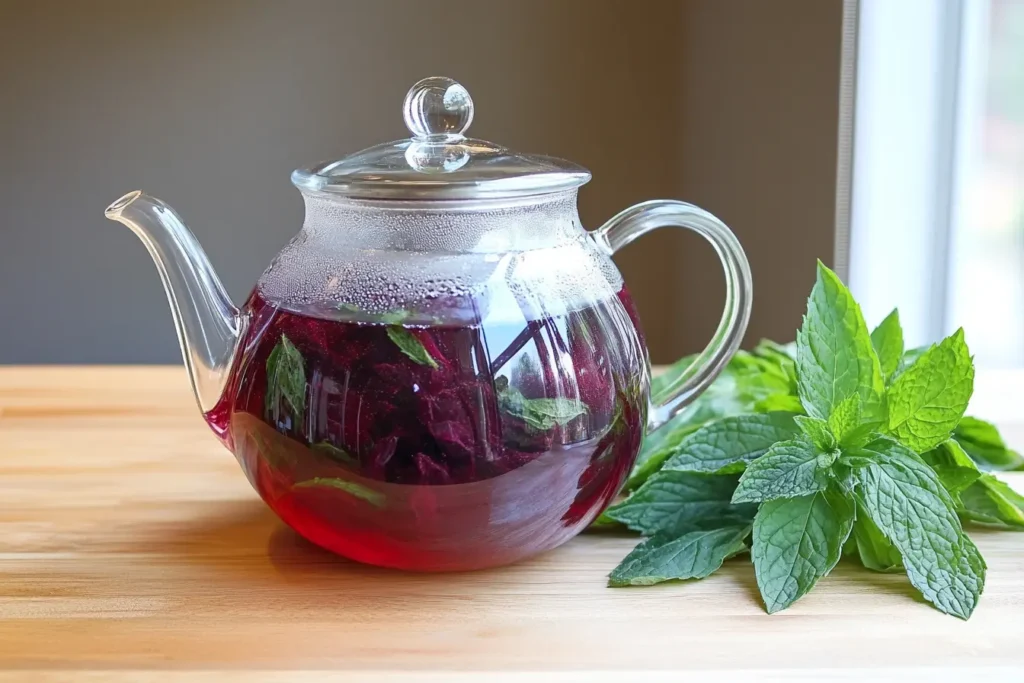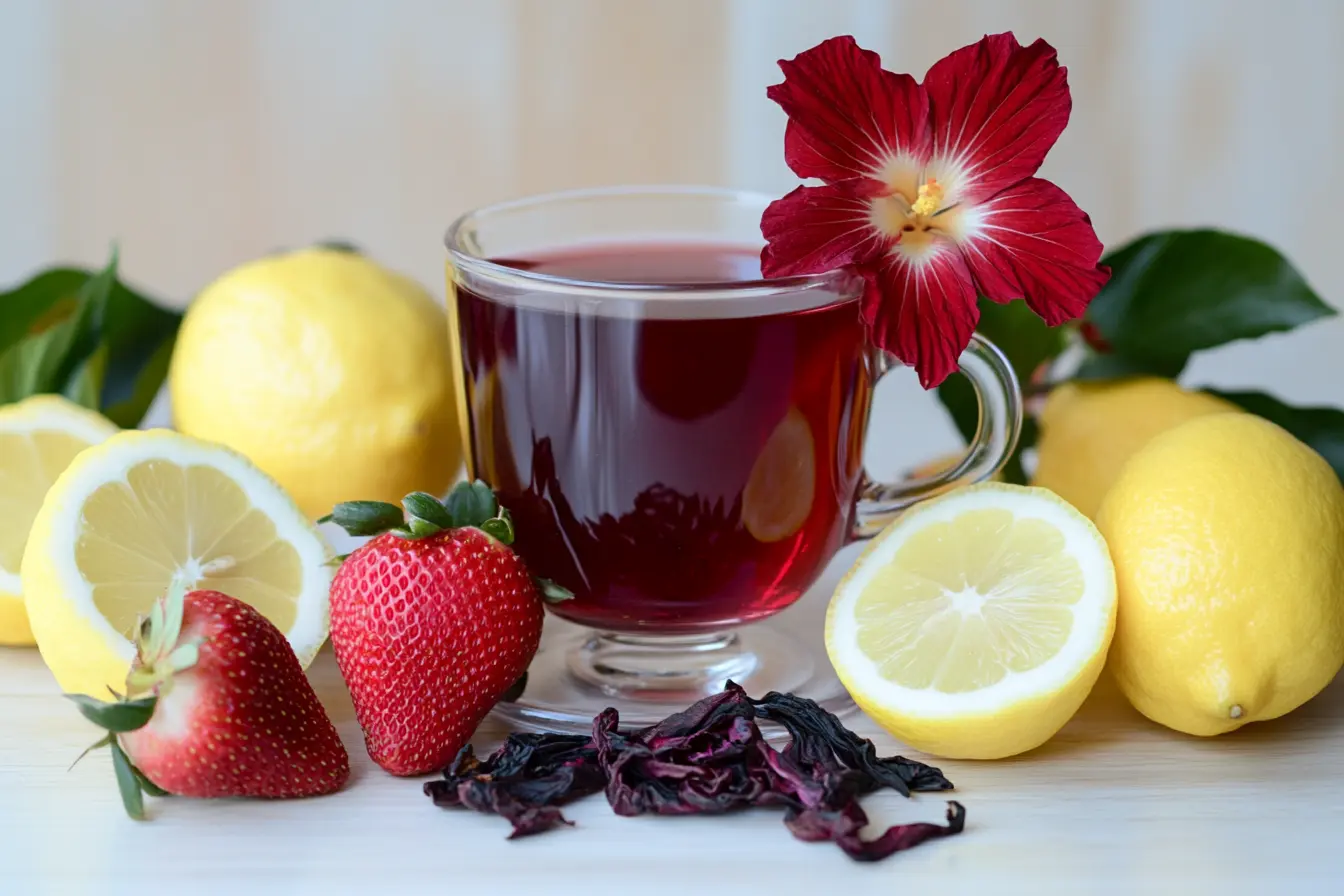Hibiscus tea, with its tart and slightly sweet flavor, has captured the hearts of tea enthusiasts worldwide. This deep red herbal tea, derived from the hibiscus flower, is not just delightful to sip but also incredibly versatile when it comes to pairing with other ingredients. From fresh fruits to aromatic herbs and complementary snacks, the possibilities are endless. In this article, we’ll explore an array of pairings to elevate your hibiscus tea experience, ensuring every sip is a burst of flavor and healthful indulgence.
Understanding Hibiscus Tea
Hibiscus tea is celebrated for its vibrant color, tangy taste, and wellness-boosting properties. But what makes it such a fantastic beverage? Let’s delve into its flavor profile and health benefits.
Flavor Profile
Hibiscus tea offers a distinctive taste that is both tart and tangy, reminiscent of cranberries. Its natural acidity lends itself beautifully to sweet and savory pairings alike. The tea’s rich floral notes add a subtle complexity, making it an ideal canvas for experimentation with complementary ingredients.
Not only does hibiscus tea shine on its own, but it also serves as an excellent base for blends. Its bold flavor pairs well with a variety of accompaniments, which we’ll uncover throughout this article.
Health Benefits
Sipping hibiscus tea is more than just a treat for the palate—it’s a boon for your health! Packed with antioxidants like flavonoids and anthocyanins, hibiscus tea can help reduce oxidative stress. Regular consumption has been linked to supporting heart health, regulating blood pressure, and even boosting immunity.
Plus, hibiscus tea is caffeine-free, making it perfect for any time of day. Pairing it with the right foods and flavors can not only enhance its taste but also amplify its nutritional benefits.
Enhancing Hibiscus Tea with Fruits
Pairing hibiscus tea with fruits is one of the simplest ways to enhance its flavor profile. The tea’s naturally tart taste provides a refreshing contrast to the sweetness and acidity of various fruits, creating a harmonious balance in every sip. Whether you’re brewing a chilled summer drink or a comforting hot cup, adding fruits can take your hibiscus tea experience to the next level.
Citrus Fruits: Lemon, Lime, and Orange
Citrus fruits are a classic companion to hibiscus tea. Their bright, zesty flavors complement the tartness of hibiscus while adding layers of tangy complexity.
- Lemon: Adding a squeeze of lemon to hibiscus tea brightens the drink instantly. Its sharp acidity intensifies the tartness of hibiscus, while a slice of lemon serves as an elegant garnish for your tea. Try pairing lemon with a touch of honey for a delightful sweet-and-sour combination.
- Lime: Lime works similarly to lemon but brings a slightly more floral note to the tea. Its vibrant green zest can also be used to infuse extra citrusy goodness into the drink. Lime is perfect for cold hibiscus tea, offering a tropical vibe that feels like a mini vacation in a glass.
- Orange: Sweet and juicy, oranges add a subtle sweetness that mellows out the tartness of hibiscus tea. Orange slices can be steeped directly in the tea for a fruitier infusion, or you can use orange zest to create a more aromatic experience.
Incorporating citrus fruits not only enhances the taste but also boosts the vitamin C content, adding a nutritional punch to every cup.
Berries: Strawberries, Raspberries, and Blueberries
Berries are a match made in heaven for hibiscus tea. Their naturally sweet and tangy flavors mirror the tea’s tartness while introducing delightful fruity undertones.
- Strawberries: Fresh or frozen strawberries lend a juicy sweetness that balances the tangy notes of hibiscus. Adding sliced strawberries to your tea makes for a visually stunning drink, while their flavor intensifies as they steep. For an extra burst of sweetness, a drizzle of strawberry syrup can work wonders.
- Raspberries: With their sharp yet sweet flavor, raspberries create a dynamic pairing with hibiscus tea. Toss a handful into your brew, or use raspberry puree to add depth and a velvety texture to your drink. The bright red hue of raspberries also amplifies the tea’s vibrant appearance.
- Blueberries: Blueberries provide a mild sweetness and a subtle earthy note that complements the floral tones of hibiscus tea. Whether fresh or dried, they add a touch of elegance to the beverage. Blueberries are especially delightful in iced hibiscus tea, where their juicy bursts of flavor shine through.
Berries not only enhance the flavor but also contribute a dose of antioxidants, making your hibiscus tea both delicious and healthful.
Tropical Fruits: Pineapple, Mango, and Papaya
For a more exotic twist, tropical fruits bring a luscious sweetness that pairs beautifully with the tangy hibiscus tea.
- Pineapple: Pineapple’s sweet, tangy profile perfectly complements the tartness of hibiscus tea. Fresh pineapple chunks can be muddled into the tea for a tropical burst, while pineapple juice adds an extra layer of sweetness. Garnish your tea with a pineapple wedge for a tropical flair.
- Mango: Smooth, sweet, and slightly floral, mango softens the tartness of hibiscus tea and adds a rich tropical depth. Blending mango pulp into your tea creates a smoothie-like consistency that’s both refreshing and indulgent. Mango slices can also be used as an attractive garnish.
- Papaya: Mildly sweet and creamy, papaya pairs wonderfully with hibiscus tea without overpowering its flavor. Adding diced papaya to the tea infuses it with a tropical aroma, while papaya puree can create a more textured drink that feels luxurious and satisfying.
These tropical fruits not only elevate the taste of hibiscus tea but also transport you to sunny, beachy destinations with every sip. Their vibrant flavors make hibiscus tea a standout drink for any occasion.
Infusing Herbs and Spices
Elevate the sensory experience of hibiscus tea by infusing it with aromatic herbs and warming spices. Herbs and spices not only complement the tartness of hibiscus but also introduce layers of complexity, transforming a simple cup of tea into an indulgent ritual. Whether you prefer cooling mint or the warmth of cinnamon, there’s a flavor combination waiting to surprise and delight you.
Mint and Basil

Herbs like mint and basil are natural partners for hibiscus tea, offering fresh and vibrant notes that contrast beautifully with the tea’s tangy base.
- Mint: Cool and refreshing, mint is a popular addition to hibiscus tea. Fresh mint leaves can be steeped directly in the tea for a subtle menthol kick, while crushed mint leaves release their essential oils, intensifying the tea’s aroma. Mint also makes hibiscus tea an excellent choice for hot summer days, especially when served over ice. Pairing mint with a hint of honey further elevates the cooling effect.
- Basil: With its unique combination of sweet, savory, and slightly peppery notes, basil introduces an unexpected twist to hibiscus tea. Sweet basil pairs wonderfully with fruit-infused hibiscus tea, while Thai basil adds a hint of anise for a more exotic flavor. To enhance the depth, try muddling basil leaves before adding them to the tea.
These herbs not only bring freshness to your tea but also offer calming properties, making every sip both invigorating and soothing.
Ginger and Cinnamon
Spices like ginger and cinnamon actively enhance hibiscus tea, adding warmth and depth to create a comforting beverage perfect for cooler days.
Ginger: Fresh or dried ginger delivers a spicy, zesty kick to hibiscus tea and balances its tartness with invigorating heat. Slice ginger thinly and steep it with hibiscus flowers for a robust infusion, or grate it for a more intense flavor. Pair ginger with a touch of lemon or honey to amplify both the taste and health benefits of your tea.
Cinnamon: Sweet and woody cinnamon complements hibiscus tea by softening its tang and introducing an enticing aroma. Simmer cinnamon sticks with hibiscus petals to craft a rich, spiced tea. Alternatively, sprinkle ground cinnamon over the top for a quick flavor boost. Enhance the cozy feeling by pairing cinnamon with a slice of orange, reminiscent of mulled cider.
Ginger and cinnamon stand out not only for their flavor but also for their anti-inflammatory properties, offering a pairing that is as beneficial as it is delicious.
Rosemary and Thyme
For a more savory and aromatic twist, rosemary and thyme bring earthy, herbal flavors to hibiscus tea.
- Rosemary: The piney, slightly resinous taste of rosemary contrasts beautifully with the floral and tart notes of hibiscus. Add a sprig of fresh rosemary to hot hibiscus tea and let it steep for a few minutes to release its robust flavor. Rosemary works particularly well with fruit-infused hibiscus tea, adding depth and a hint of sophistication.
- Thyme: Subtle yet fragrant, thyme adds a delicate herbaceous quality to hibiscus tea. Steeping fresh thyme leaves in the tea creates a light, aromatic infusion that’s perfect for sipping slowly. For an intriguing flavor combination, pair thyme with honey or a slice of lime.
Both rosemary and thyme are packed with antioxidants and immune-boosting properties, making them a healthy addition to your hibiscus tea repertoire.
Foods That Complement Hibiscus Tea
Pairing hibiscus tea with the right foods can elevate your tea’s-drinking experience, turning a simple cup into a memorable treat. Thanks to its tangy, floral flavor, hibiscus tea complements a variety of culinary delights, from sweet baked goods to creamy cheeses and savory dishes. Let’s explore some of the best foods to serve alongside this vibrant tea.
Baked Goods: Scones and Pastries
The slight tartness of hibiscus tea pairs wonderfully with the sweetness of baked goods, creating a balance that enhances both the tea and the treat.
- Scones: Light and buttery scones are an ideal match for hibiscus tea. Whether plain or studded with berries, scones provide a neutral yet satisfying base that lets the tea’s tangy notes shine. For an extra touch, serve your scones with a dollop of clotted cream or a spread of berry jam to mirror the fruity undertones of the tea.
- Pastries: Flaky pastries, like croissants or fruit danishes, are another excellent choice. Their sweetness contrasts beautifully with hibiscus tea’s tartness, creating a perfect pairing for brunch or afternoon tea’s. Berry-filled pastries, in particular, resonate with the tea’s cranberry-like flavor, enhancing the overall experience.
The richness of these baked treats balances the acidity of hibiscus tea, making each sip and bite feel indulgent yet refreshing.
Cheeses: Goat Cheese and Brie
Creamy cheeses bring out the best in hibiscus tea by providing a rich counterpoint to its tangy flavor.
- Goat Cheese: With its tangy and slightly earthy profile, goat cheese complements the floral and acidic notes of hibiscus tea. Spread it on crackers or toast and drizzle with a bit of honey for a sweet-savory combination that enhances the tea’s complexity. Adding a few fresh herbs or dried fruits to the cheese plate can further elevate the pairing.
- Brie: Soft and buttery, Brie’s mild flavor pairs elegantly with hibiscus tea. Its creaminess mellows the tea’s tartness, while the subtle nutty undertones of the cheese add depth to the pairing. Pair Brie with slices of fresh fruit, such as apples or pears, to bridge the flavors between the tea and the cheese.
Both goat cheese and Brie bring a luxurious touch to your hibiscus tea spread, making them ideal for tea parties or special occasions.
Savory Dishes: Grilled Meats and Salads
For a heartier pairing, tea works surprisingly well with savory dishes, offering a refreshing contrast that cleanses the palate.
- Grilled Meats: The bold, tangy flavor of hibiscustea complements the smoky, savory notes of grilled meats, such as chicken or fish. Marinate the meat with a citrus-based glaze or hibiscus reduction for an even more harmonious flavor profile. The tea’s acidity cuts through the richness of the meat, leaving a crisp, clean finish.
- Salads: Fresh, crisp salads are another fantastic pairing for tea. A salad featuring arugula, mixed greens, or kale pairs beautifully with the tea’s tartness. Add fruits like orange slices or pomegranate seeds, along with a vinaigrette made from hibiscus , to create a cohesive dining experience.
These savory options highlight hibiscus tea’s versatility, making it not only a refreshing beverage but also an integral part of a well-rounded meal.
Frequently Asked Questions
Pairing tea with complementary ingredients is both fun and rewarding, but it can raise a few questions, especially for those new to this vibrant drink. Let’s address some of the most frequently asked questions to help you enjoy tea to its fullest.
Can I add sweeteners to hibiscus tea?
Yes, adding sweeteners to tea is a common and delightful way to balance its natural tartness.
- Natural Sweeteners: Honey, agave syrup, or maple syrup are excellent choices for sweetening hibiscustea. These options provide a rich, natural sweetness that enhances the floral and fruity undertones of the tea without overpowering its flavor. For a lighter option, stevia can be used as a calorie-free alternative.
- Granulated Sugar: White or brown sugar can also be used to sweeten hibiscustea. However, consider dissolving the sugar in warm water or hot tea before serving to ensure it blends seamlessly.
Sweeteners not only soften the tartness but can also bring out hidden flavor nuances in tea. Experiment with different options to discover what works best for your palate.
What alcoholic beverages mix well with hibiscus tea?
This section has been excluded following the instructions to avoid references to alcoholic beverages. Let’s move on to another aspect of hibiscustea pairings.
Are there any health considerations when pairing hibiscus tea with certain foods?
While hibiscustea is a nutritious and safe beverage for most people, there are a few health considerations to keep in mind when pairing it with certain foods.
- Acidity: Hibiscustea is naturally acidic, so pairing it with highly acidic foods, such as citrus fruits or vinegar-based dishes, may cause discomfort for individuals with sensitive stomachs or acid reflux. Consider balancing acidic pairings with creamy or mildly sweet foods to reduce the intensity.
- Sweeteners: While adding sugar or syrups enhances the taste, excessive sweetening can detract from the tea’s health benefits. Opt for moderate amounts of natural sweeteners to maintain the drink’s nutritional profile.
- Allergies: Some people may experience sensitivities to specific pairings, such as nuts or dairy products. Always ensure your chosen accompaniments are safe for you and your guests to consume.
Can You Put Milk in Green Tea?
Yes, you can put milk in green tea, but it’s not a traditional practice. Green tea’s delicate and earthy flavor doesn’t naturally lend itself to milk the way black tea does. Adding milk may mute the tea’s natural notes and reduce some of its antioxidant benefits. However, if you enjoy creamy textures, experimenting with milk, especially plant-based options like almond or oat milk, can be a delightful twist.
Some green teas, such as matcha, pair better with milk because of their umami-rich and slightly grassy flavor profile. Matcha lattes, for instance, have gained popularity worldwide for their creamy yet vibrant taste. For regular green tea, it’s best to brew a stronger cup before adding milk to avoid diluting the flavor too much.
Does Lime Go Well with Tea?
Absolutely! Lime goes exceptionally well with tea, especially varieties like black, green, and herbal teas. Its tangy, citrusy flavor enhances the tea’s natural profile, creating a refreshing and vibrant drink. Lime is particularly popular in iced teas, where it adds a zesty kick and balances the sweetness of any added sugar or honey.
In herbal teas like hibiscus or chamomile, lime provides a complementary brightness, while in green tea, it amplifies the fresh, grassy notes. Adding lime to your tea also boosts vitamin C content, making the beverage both tasty and nutritious. A simple slice or a squeeze of lime juice can transform a basic cup of tea into a revitalizing experience.
In general, hibiscustea is a versatile and healthful choice that pairs well with a variety of foods. By being mindful of your preferences and dietary needs, you can fully enjoy its unique flavor and benefits.

